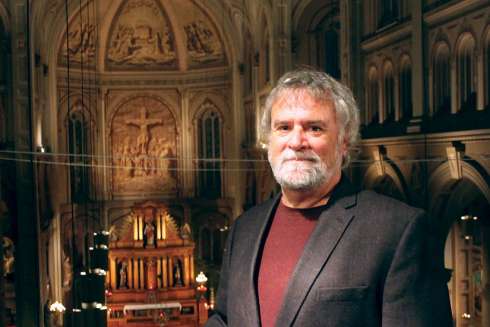There is really no other church like it in Canada. The city landmark is celebrating its 150th anniversary. It holds the remains of three of the Jesuit Canadian martyrs and is a former college chapel that had its basement converted into an auditorium in 1923.
One of Montreal’s oldest cultural centres, the auditorium launched such important Quebec acts as Anciens du Gesù, Théâtre Rideau Vert and Théâtre du Nouveau-Monde. The careers of notable cultural figures Jean Gascon, Jean Louis Roux and Gratien Gelinas were nurtured at the Gesù.
Perhaps because of its proximity to Place des Arts and Montreal’s arts and entertainment district, the rector, Fr. Daniel Leblond, opened the church itself in 1995 as a creative arts centre.
Thanks to Leblond’s efforts the Gesù has become a sanctuary for what Universite de Montreal theology professor Solange Lefebvre calls a community of “fragile Catholics” — a place of worship for those who have distanced themselves from the Church in Quebec but accept its spiritual teachings.
Leblond, who is also a former provincial of the French-speaking Jesuit province in Canada, is a professional artist and photographer. He admits a certain tension exists between the Gesù’s ongoing religious role and its evolution as an arts centre.
“Art is not religion, but art and religion are not opposites, they complement each other,” he says.
The Church has a role to play to encourage people to interact with God through art, with the understanding that “historically, many of the great artists made their way through the Church.”
The Gesù was built in 1865 as a college chapel 30 years before Montreal had a proper Roman Catholic cathedral. To understand why events occurred in that order it is necessary to understand 19th-century ecclesiastical politics.
After New France became a British possession in 1763, the Jesuits, who had been in New France for 150 years, were expelled from British North America and their estates seized by the crown. The Sulpicians owned the Island of Montreal and were allowed to keep their seigneurial rights. Tensions arose in 1819 when Quebec appointed Jean-Jacques Lartigue as Montreal’s auxiliary bishop.
The Sulpicians resented the unilateral appointment and refused to allow Lartigue to use their church of Notre Dame as a cathedral. This unleashed a lengthy schism between the Sulpicians and the diocesan bishops.
In order to consolidate his episcopal authority and wrest control of his diocese from the Sulpicians, Lartigue’s successor, Bishop Ignace Bourget, invited the Jesuits to return to Montreal in 1842 to open a school which could rival College Montreal, which the Sulpicians had run since 1767. It took six years before the Jesuits finally opened College St. Marie.
Bourget then launched a public appeal for funds to build the promised college chapel that would be a copy of Chiesa del Santissimo Nome di Gesù, the Jesuits mother church in Rome. The appeal failed and extravagant plans were scaled back by the Irish-born architect Patrick Keeley. The Gesù finally opened Dec. 3, 1865.
The Baroque grandeur of the church is deceptive. When you enter, the nave appears truncated until you reach the transept which soars three stories (23 metres) and the space opens to six magnificent side altars. The grey and gold trompe l’oeil frescoes are by 19th-century New York decorator Daniel Muller. There are also two massive canvases by an Italian master, Giovanni Gagliardi, as well as a copy of Carravagio’s death of St. Francis Xavier.
An ornate reliquary contains the remains of Jesuit martyrs Charles Garnier, Gabriel Lalemant and Jean de Brebeuf.
Among the church treasures is a replica of the original statue of Notre Dame de Liesse. The legend surrounding the statue goes back to the Crusades when three captured French soldiers prayed in their prison cells to Mary. Overhearing their devotion, a Muslim princess asked the captives to carve an image of Mary or face execution. The soldiers, who were not artisans, awoke the next morning to find the ornate statue in their cell. They were released and took the carving back to France where it graced the royal chapel. The original was burned during the French revolution but the ashes were entrusted to the Jesuits and deposited in the base of a copy they brought to Montreal.
In 1960, the Jesuits announced plans to demolish the Gesù and the adjoining College St. Marie to make way for the campus of a planned Catholic university. The Quebec government, however, had embarked on the so-called Quiet Revolution and began to distance itself from faith-based public institutions. The university was never built. College St. Marie closed in 1969 and its buildings were torn down in 1976, eventually replaced by a skyscraper.
Proceeds from sale of the property permitted the Jesuits to restore the Gesù in 1984. The Gesù was declared a Quebec historic monument in 1975 and recognized as a Canadian cultural heritage property in 2012.
(Hustak is a freelance writer in Montreal.)


